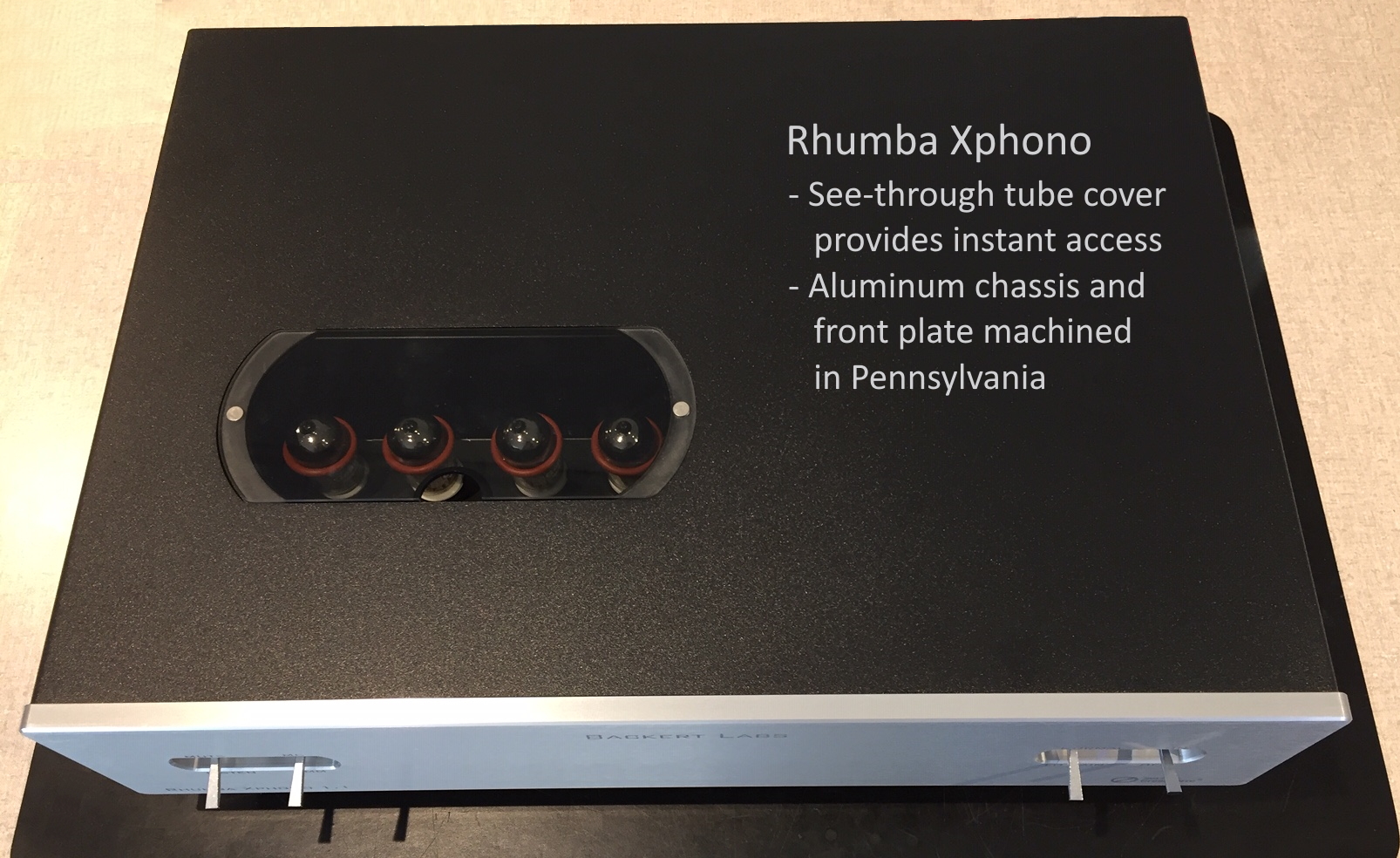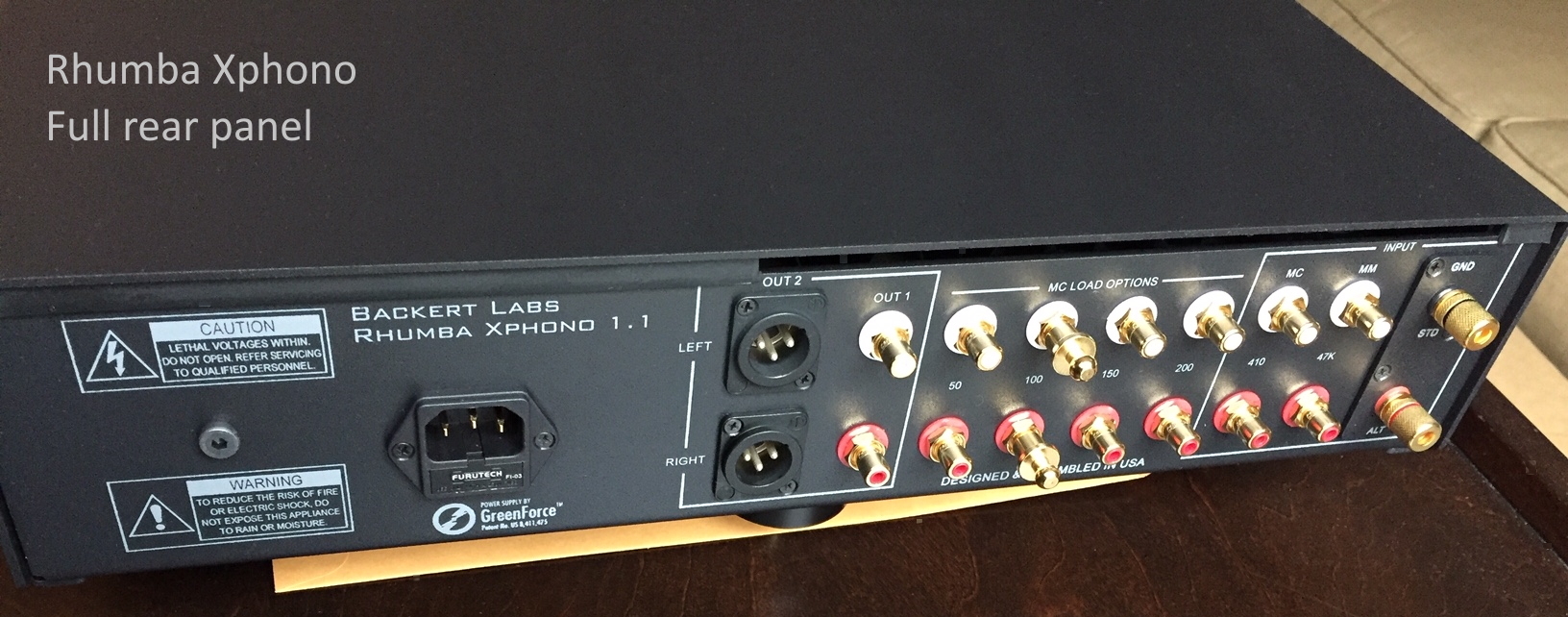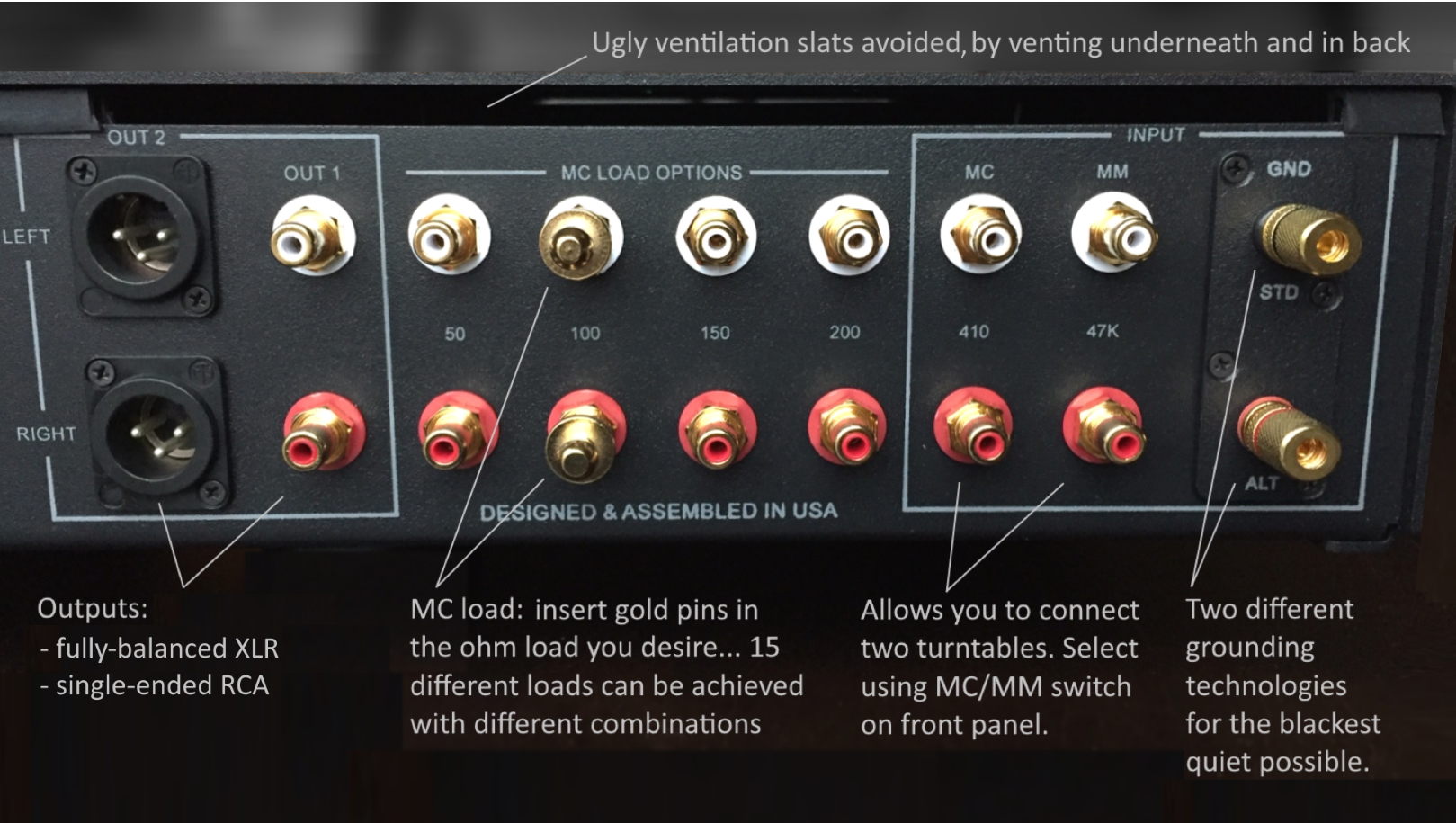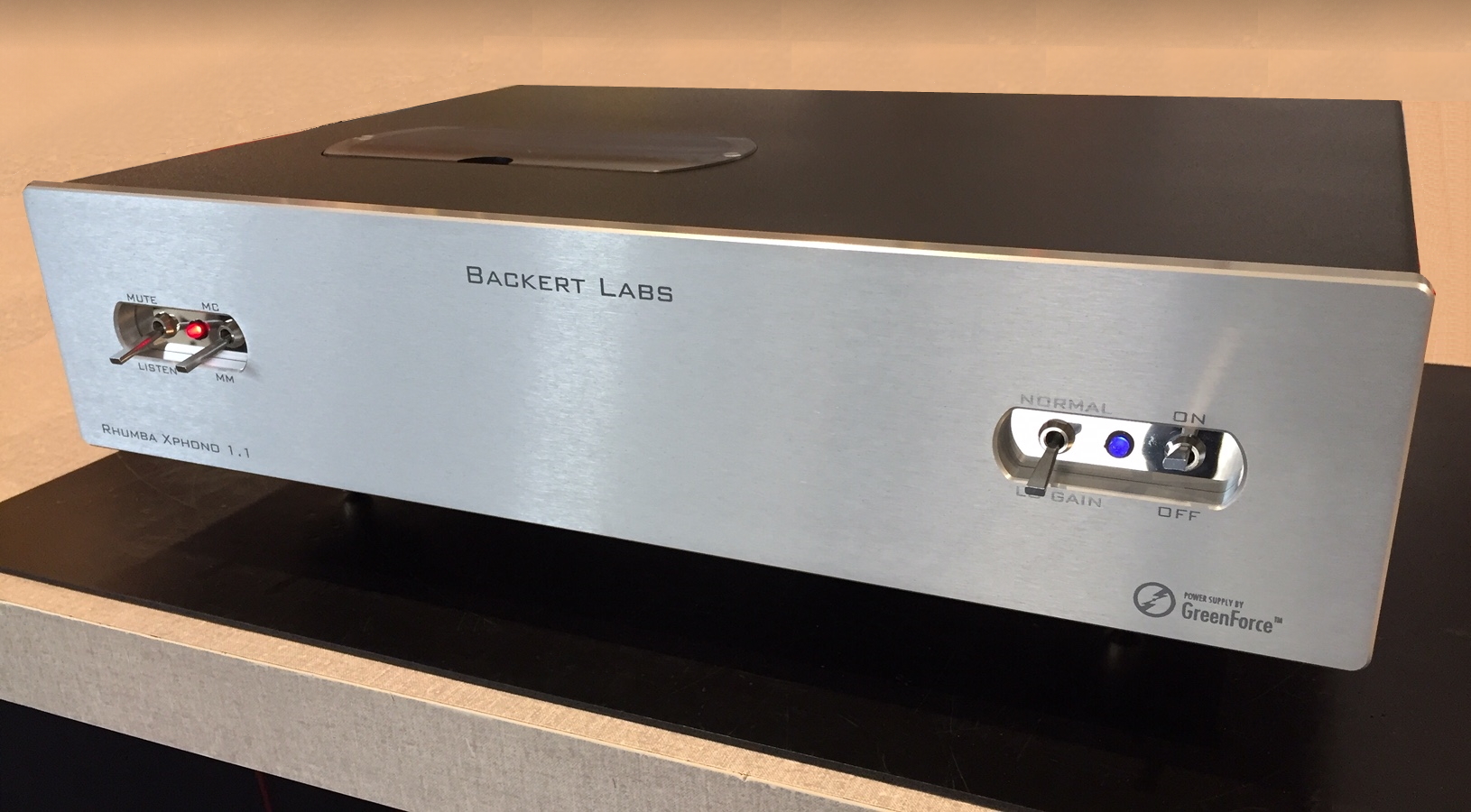
“Just across the line of demarcation from the rest of the herd that sounds good enough, the Rhumba Xphono has that fleeting thing that takes you on a magic carpet ride.” – TONEaudio magazine, October 2022, page 60
The Backert Labs “Rhumba Xphono” phono preamp is $7,800. It includes:
- MM and MC inputs, via separate RCA input pairs
- MM/MC switch on front panel
- Gain switch on front panel gives easy access to 2 different levels of gain for both MM and MC
- MC: 67 or 61 dB
- MM: 47 or 41 dB
- Fully balanced XLR output and traditional single-ended RCA output
- Backert Labs’ famous auto bias for all four 12at7 tubes
- GreenForce power supply
- Gold Lion “gold pin” 12at7 tubes
- Easy tube access with our tube door on the top panel
- Mute switch on front panel
- 15 different load options for MC
- Changing MC load is easy: just plug in the supplied RCA plugs on the back panel
- 2 MC cartridges can be used at the same time, by feeding one into a step-up transformer leading to the MM input
- Two different grounding options for the ground wire coming from your turntable — “chassis ground” and “power supply ground” — select the option that is most quiet in your system
- Solid brass feet, the same ones found on our Rhumba Extreme linestage.
We have always loved our LPs.
When we come home to our records, we want exhilaration. Intimacy. A compelling, moving experience. Boring sound simply will not do.
We knew we could get more from our vinyl. So we developed a phono preamp that works in a new way, to produce the emotional beauty we crave from our records. It’s called the Rhumba Xphono. It’s $7,800, and it’s going to change what you hear from your records.
That Feeling.
Bob Backert started the design of our phono preamp with GreenForce, his patented power supply. It’s more nimble than other power supplies. As a result, it propels a “happening-right-now” performance into your listening room.
He then added the tubed amplification circuit from our award-winning Rhythm linestage preamp. Big. Dynamic. Rhythmic. And faithful to the precise tone created by the performers on your favorite recordings. But he wasn’t finished.
Easy.
One of the founding principles of our company is that owning a tube preamp should be easy. So we’ll ask you about your cartridge, and configure your Rhumba Xphono for your system. You’ll be playing records in minutes. And if you change your cartridge later, adjusting your Rhumba Xphono will also be a breeze.
What about the tubes? Maybe you love tubes, or maybe you’ve never held one in your hand before. Either way, it’s OK. The Rhumba Xphono uses four 12at7’s, one of the most popular tubes in history. They are plentiful, and affordable. And Bob Backert designed the Rhumba Xphono so you won’t need to think about them much, because the Rhumba Xphono babies its tubes. We run them so gently, they might just outlast all of us.
You can easily lift our special tube door to replace the tubes, if you want to see how another brand sounds. (After turning the unit off, of course.) The tube door makes changing tubes as quick and easy as changing a light bulb.
The Phono Preamp Issue.
After putting these elements together, Bob Backert went a step further. He decided to tackle the phono preamp problem that nobody talks about. First, some background: a phono preamp isn’t just one amplifier. The music signal from your records travels through at least two stereo amplifiers in a phono preamp. One immediately following the other. That’s true whether your cartridge is MM, or MC.
Phono preamps need “two amplifiers in a row” like this, otherwise, the music signal wouldn’t be amplified nearly enough.
The problem: most phono preamps force these two amplifiers to share the same power supply.
That’s especially unfortunate in a phono preamp, because every amplifier “tugs” on its power supply as it amplifies music. So by doing their job, amplifiers disrupt the very power that feeds them.
So if an amplifier shares its power supply with another amplifier, its power gets doubly disrupted. This is the phono preamp problem that nobody talks about — two amplifiers in a row, both of them sharing the same power supply, and both of them disrupting the power being fed to them.
But the problem is even worse than you might expect. In a phono preamp, the first amplifier handles the very tiny signal coming straight from your cartridge. We’ll call this tiny music signal Tinkerbell. After passing through the first amplifier, this tiny music signal has grown much larger — dozens of times larger. It is then sent to the second amplifier, and again gets amplified to become dozens of times larger. Compared to Tinkerbell, the music signal in the second amplifier is like King Kong.
When you think about the tugging and disruption that every amplifier inflicts on its power supply, it becomes clear: for the Tinkerbell music signal in the first amplifier, sharing her power source with King Kong over in the second amplifier is bad news. If a single power supply is shared, Tinkerbell’s power source is constantly disrupted by her, and by the King Kong music signal in the other amplifier, which places much larger demands on the power supply. As a result, Tinkerbell has more difficulty getting pure, steady power for the tiny requests she is making to the power supply. This is how traditional phono preamps are built — two amplifiers in a row, both of them sharing one power supply, and both of them disrupting that power supply.
Fixing the problem.
To deal with this issue, in the Rhumba Xphono, Bob Backert uses a separate, dedicated power supply for each amplifier. Or as an engineer would say it: a separate power supply for each gain stage. This used to be reserved for phono preamps in the $10,000-and-up range. Now it’s here, in the Rhumba Xphono.
It’s a phono preamp that sounds like a Backert Labs.
What about the additional amplifier that MC cartridges require? In the Rhumba Xphono, that’s a passive amplifier (a step-up transformer), which doesn’t need a power supply.
Do phono preamps with “dual mono” power supplies fix this problem?
No. Dual-mono means “separate power supplies for the left and right channels.” But each channel still sends the music through two amplifiers in a row, one after the other, as we have discussed. And in other phono preamps, even ones with dual-mono power supplies, those two stages of amplification share the same power supply. So dual-mono power supplies do not address the Tinkerbell/King Kong problem.
More goodies.
So, as we designed our phono stage, we made things easy for you. We also addressed the phono preamp problem that nobody talks about. And we brought totally new technology to the power supply and the gain stage, to make the sound extraordinary. What else did we build into the Rhumba Xphono?
Well, the Xphono’s front face can be silver or black (a no-cost option). In addition, you can have the body of your Rhumba Xphono powder coated in a beautiful red or blue for $300 more. Further, the Rhumba Xphono:
- is designed and built by Bob and Gary Backert in Pennsylvania
- includes our famous tube cover, giving you instant access to its four 12at7 tubes
- uses our proprietary gain stage for the highest resolution sound
- uses beautiful brass feet made for us by edenSound audio
- is a pure Class A design
- uses no feedback — neither global, nor local
- has a custom-designed toroidal power transformer
- features a beautiful hi-tech exterior with no screws, no fasteners and no ventilation holes visible anywhere
- has all the other goodies that come with a Backert Labs preamp.
Try One
You put a lot into your stereo system, and you deserve to have us working on it for you. Decades of amplification and electronic design expertise, and decades of live musical performance experience, working together. That is Backert Labs.
Call one of our dealers, or give us a call directly at (302) 723-7549. It’s time to hear what your records can really do.





It’s so new, we don’t even have fancy photos of it yet.

